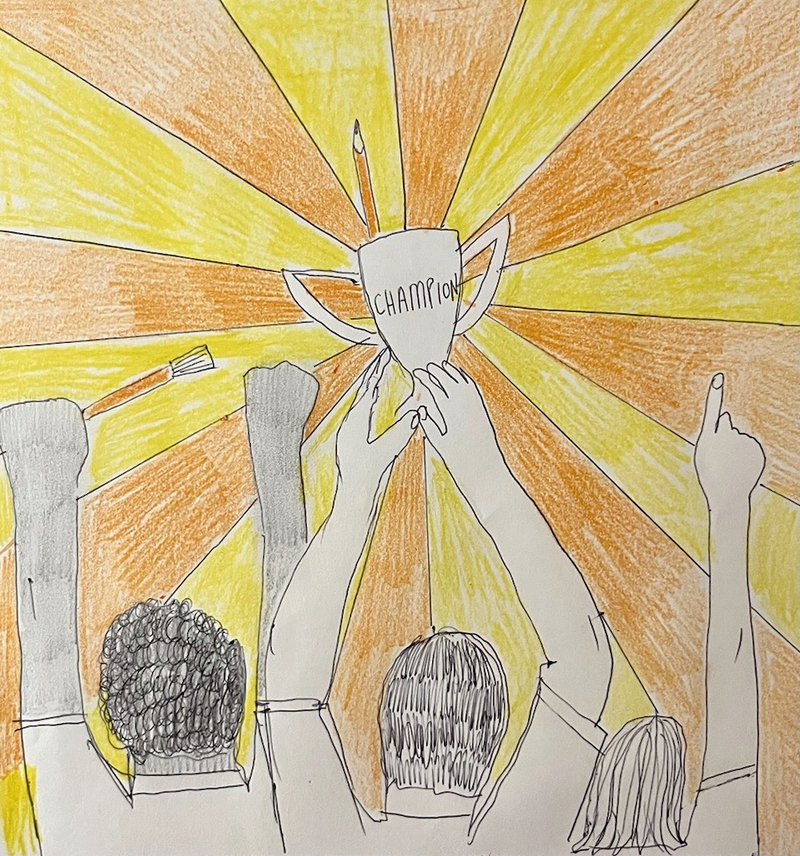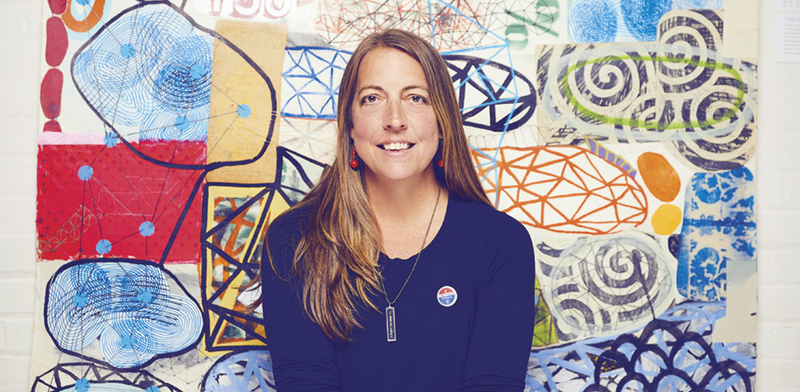
“Under the seeming disorder of the old city, wherever the old city is working successfully, is a marvelous order for maintaining the safety of the streets and the freedom of the city. It is a complex order. Its essence is intricacy of sidewalk use, bringing with it a constant succession of eyes. This order is all composed of movement and change, and although it is life, not art, we may fancifully call it the art form of the city and liken it to the dance — not to a simple-minded precision dance with everyone kicking up at the same time, twirling in unison and bowing off en masse, but to an intricate ballet in which the individual dancers and ensembles all have distinctive parts which miraculously reinforce each other and compose an orderly whole.” — Jane Jacobs, journalist and author of The Death and Life of Great American Cities.
When a work of art is created, praise or criticism often follows, and those reactions are usually directed toward the artist who created the work. Behind every artist, there is often an individual, team of people or bureaucracy who assists in the delivery of that art being consumed by the public. A healthy or unwell business, industry or sector has outcomes that hinge on the character and integrity of its leadership. Not all leaders are champions.
Some artists work within the nonprofits infrastructure, whether they be galleries, publishers, theaters or performing centers. In this nonprofit space, artists are consistently entangled in crosshairs where they need to justify their art through specific funding criteria. The artist’s creative output more times than not comes with strings attached. Individual artists funding is reliant on the alignment of the nonprofit organization’s programmatic and prescriptive needs required by foundations, the City of Cleveland, Assembly for the Arts, or Cuyahoga Arts and Culture.
The “Art for Art’s sake” unrestricted grants flew away years ago but word on the street is that they are making a comeback. Thing is — the process of support for artists grants continues to be again in transition, hastily developed, slapdash and pushed through with zero public discussion. Cuyahoga County, like the rest of the nation, did a terrible job at equitably distributing unrestricted grants particularly to Black, Indigenous and artists of color.

Supporting artists equitably in Cuyahoga County, where all disciplines, genres, histories, demographics, practices, ages, abilities, skill levels and content are currently being judged by some algorithmic backdoor, should not be a whack-a-mole process whereby those in the vacuum select chosen pass-through nonprofit organizations to deliver support to artists. Decisions being made without an iota of transparency or ANY process, period, excludes all the other equally fabulous nonprofit pass-through organizations from even applying. This is not equity. Champions are clear and confident and articulate their decisions with discernment whereby opening the doors to other organizations so they can apply too. Champions understand that fair and broadly communicated systems of outreach give other organizations an equal chance to participate, thus strengthening the bonds and opportunities with the artists in their respective neighborhoods.
Artists of color struggle because resources and opportunities are structurally and systematically denied to them. Artists of color and arts organizations established and led by people of color don’t get the resources they need to survive, let alone to thrive. We must change the minds (leadership and decision making) and the mechanisms (the institutional policies and practices) that prevent more equitable distributions of resources. We need champions!!!
Course correction for equitably supporting artists is still in the hands of a few who all certainly feel that they bring only the best intentions and expertise to the work. However, they continue to avoid any public conversations about the strategic moves and decisions they are making. The decision makers’ vantage points are lofty and detached, and the soul of the cultural community remains organically on street level, waiting for the predetermined decisions made on the artists’ behalf to be handed down by those that are not artists.
A reality exists where art and culture in Cuyahoga County can’t be discussed openly because the people in the vacuums at the city, county and foundations (all of whom have their agendas regarding equitable distribution to artists) keep it sealed tightly. The keyholders who drive arts and culture have already pre-determined strategies without dedicated public discussion or exchange. Policies, theories and procedures are in motion by those in the vacuum. Individual artists are the pedestrian bystanders where the only option for artists is the drive-by, so “progress” can be made and the drivers can repave the road ahead for the rest of us. The fortressed few who have the positions of centralized authority have amassed power that evades any oversight so they can continue operating in the vacuum.
An arts and cultural champion cracks open the pain, trauma and barriers of our shameful history of institutional racism, and they talk about it and take action. Champions find ongoing ways in accessible public forums to discuss these issues in the open. Champions don’t talk behind closed doors. Champions don’t talk out of both sides of their mouth.
A champion is far-seeing and speaks truth to power. A champion sees artists as allies and as direct activators bringing their art to neighborhoods, schools and public spaces. If artist projects are being used for social services, safety, community development or any other purpose, it should be understood at the onset of the program/project announcement, not after artists have already raised support through their advocacy and repurposed it later to suit the needs of those in the vacuum.
Champions are direct, and they confront artists with what they are going to do before the decisions have already been made. Champions inspire our arts and culture sector to work together in tough times and engage everyone to figure issues out together. Champions see abundance, connectivity and support. Scarcity is never used to make artists fear the future. We all know the resources are declining, but champions inspire all of us together to figure things out in unity. Champions don’t make excuses for others and own up to their missteps. Champions don’t carry the water for their superiors. Champions, no matter good news or bad, inspire with honesty and directness.
Champions are visionaries, inspiring and celebrate equity by being mutually supportive to diversity, accessibility and differing enterprises. A true champion is fluent, passionate, and explicit in antiracism and social change work. The cultural leadership of this region needs champions who are performing, practicing and teaching artists. Champions recognize the merits of including individual artist-leaders and representing them at all levels of the creation of a cultural plan. Artists who sing, sew, screenplay, sonnet, stream, salsa, strum and support one another across Cuyahoga County. Champions see the holistic support of large and small organizations and how the entire sector can work together. Champions have remarkable curiosity and look to our individual artists’ strengths so they can reinforce those assets of creative problem solving and design-thinking.
There are champions here in Cuyahoga County who focus on taking chances by providing artists with the freedom, respect, resources and support that they need to produce their art. Champions have no interest in praise. Champions mobilize art and culture in meaningful, consistent, and profound ways. Champions can’t stomach patronizing cronyism. Champions are visionaries. Solutions rarely come from inert government offices or city planners but from those that have the willingness to be skeptical from what they truly see. Champions are active and build relationships across sectors and see everything as interconnected.
Here is a list of champions who work from the edges and have succeeded with their sustained resourcefulness and self-reliance intact. In fact, perhaps like the band Queen, their anthem to stomp and clap in unison holds true, “We are the champions”. Join me in adding to this list and let’s make it grow. Who inspires you and has been working from the edges and is doing great creative things in our community? I have been inspired by the artists and arts organizations who are not waiting around for permission to strategically organize, to create forums, to network, and to create, find and share resources. I’m enthusiastic about the great work that is happening to develop more leaders from diverse communities, to increase traditional support, to develop alternative means of support, and to advance networks.
Let’s keep building this list!
William Busta and Joan Tompkins, gallery
David Ramsay, Deep Roots Experience gallery
Cindy Barber, Beachland Ballroom
Sean Watterson, Happy Dog music venue
Thomas Mulready, Bruce Checefsky and Anastasia Pantsios, arts and culture media CoolCleveland.com
Tim Herron, The Pretentious Portrait Artists
Dave Megenhardt, Red Giant Books, Publisher
April Bleakney, visual artist, APEMADE
Dr. Rev. Leah Lewis, filmmaker/entrepreneur
Robert Banks, filmmaker/teacher
Ali and Donald Black Jr., poet/photographer/teachers
Mistersoul, artist/muralist/designer
Jordan Wong, Designer/Teacher
Dr. Jacinda Walker, Design Explorr/educator
Stephanie Kluk, Future Ink Graphics
Antunesia Harris, community convener, Invigorate Hough
Antoine Washington & Michael Russell, MOCHA/teachers artists
Dayzwhun, artist, Red Lion Tattoo and gallery, muralist
Dan Rothenfeld, artist, public art
Amber Ford, photographer, artist
Keisha Nicole Foster, poet
Liz Maugans is a Cleveland-based artist, mom of three great kids, a social justice advocate, an educator, a gallerist, and curator. Maugans co-founded Zygote Press, the Collective Arts Network, the Cleveland Artist Registry and the Artist Bridge Coalition. Currently, Maugans is the Chief Curator of the Dalad Collection and Director of Yards Projects at Worthington Yards. Maugans teaches Artist-in-Communities and Museums and Collections at Cleveland State University and is Chief of Community Engagement at Art Everyspace. Maugans sits on the Board of the Collective Arts Network and Refresh Collective. Her work is represented by Hedge Gallery at 78th Street Studios. www.lizmaugansart.com

2 Responses to “CULTURATI: We Are the Champions by Liz Maugans”
Liz Maugans
Thought of some more…
Ray McNiece, poet and musician
Mary Kay Thomas, artist, muralist
Gwendolyn Garth, artist and social justice arts advocate
Michael Loderstedt, artist, poet, former gallerist
Vince Robinson, artist, musician. Arts advocate
Hilary Gent, artist gallerist
Joan of Art
Doubting Thomas Gallery
Douglas Max Utter, artist, writer
Stephen Calhoun
I wonder how to really activate the concept of “Champions?” It seems obvious to me all this organizational and aspirational talent should be regularly convened; surveyed; and thus organized.
Here are a few to be added:
M Carmen Lane & ATNSC
Gina Washington
Anna Arnold
Shari Wilkens & CPR
Ingenuity Fest team
Rooms to Let team
Mindy Tousley & AAWR
I get the insular and status-anchored capacity challenge at the institutional level, yet, it is very clear to me that our art scene’s vibrancy is checked by the close to total lack of PUBLIC critical capacity. This is a problem that can be solved by artists themselves organizing to create this capacity. The effort to introduce artists to each other’s deep creative capacities and intentions and histories would take a considerable organizational effort—maybe a step for Artist’s Bridge Coalition? And, this requires documentation too.
Could Cleveland become a world leader in communal critical capacity. Aim high!
The other thing is that there are elephants in various rooms! The transactional (and often facile) answers to equity and inclusion are not anchored to public dialogues or vigorous deconstructive efforts or introductions of transformational paradigms. It is very easy to reverse hierarchies in ultimately destructive ways.
That said, invigoration of social consciousness is nourished by engaged pluralism and recasting ideological dead ends in generative ways.
imo